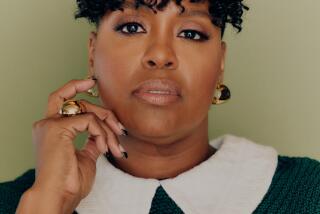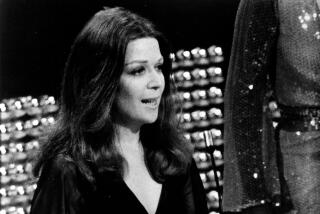TV WOMEN: A LONG WAY TO GO
- Share via
You’ve come a long way, baby.
Flash back to an episode of “The Dick Van Dyke Show” (1961-66 on CBS), easily the funniest and smartest sitcom of its time, but still a product of its time.
For the record:
12:00 a.m. March 15, 1986 FOR THE RECORD
Los Angeles Times Saturday March 15, 1986 Home Edition Calendar Part 5 Page 2 Column 6 Television Desk 1 inches; 17 words Type of Material: Correction
The caption on a photograph in Friday’s Calendar inadvertently identified actress Jean Stapleton as Maureen Stapleton.
Laura Petrie (Mary Tyler Moore) wants to fill in as a typist in the office of her comedy-writer husband, Rob (Van Dyke), until the arrival of “the new girl,” otherwise known as female office worker. Rob’s against hiring Laura, even temporarily, but finally gives in.
Laura turns out to be terrific, a typing whiz who even gives Rob lessons on comedy writing. What’s more, she secretly takes naps on her lunch break so that she can get up earlier each morning and still have time to do her usual housewifely chores, proving that she can hold an office job “and keep home running smoothly too.”
Rob can’t take it. He finally admits his fear to Laura, that she’ll want to “go right on working.” Not to worry, though. Laura assures Rob that her goal is only “to be useful and help my husband.”
End of story. End of career.
“The Dick Van Dyke Show” is one of five former series being highlighted in a presentation titled “Working Women on Television: The Situation Comedy 1950-1970,” at 8 p.m. Wednesday at the County Museum of Art.
The sitcom screenings are part of an ambitious TV festival at the museum running through March 22 and brought here by New York’s high-minded Museum of Broadcasting.
Besides the Van Dyke show, you will also be able to see bread-winning women in epsodes of “Our Miss Brooks” (1952-56); “Meet Millie” (1952-56); “Private Secretary” (1953-57), and “Julia” (1968-71) in a Wednesday program introduced by Ann Sothern and Rose Marie.
Sothern, who was secretary Susie McNamara in “Private Secretary,” and Rose Marie, who played Rob’s man-lusting comedy writing pal, Sally Rogers, in “The Dick Van Dyke Show,” also joined Linda Lavin, Valerie Harper, Jean Stapleton and Elena Verdugo in a working-women-on-TV panel this week at the museum. Collectively, their TV careers span 34 years of sitcoms and seven Presidents.
Sitcom females gained credibility when shows began opening their doors to women writers in the 1970s, said Harper, TV’s former Rhoda, who is now trying a comeback as a mother and homemaker with a part-time job in NBC’s “Valerie.”
“There is not a show about just a homemaker anymore,” said Lavin, who was the widowed waitress in “Alice” on CBS. “Everybody works, which is the reality.”
Reality is relative, but the sexist “reality” of older sitcoms is sometimes hard to stomach from today’s vantage point. Joshua Meyrowitz recalls TV’s old times in his new book, “No Sense of Place,” which measures the impact of electronic media on social behavior:
“By and large, the home was the women’s world; the outside world was men’s. It was understood that some women would work. But preferably this work was to be before marriage, perhaps in a job where they could ‘hook’ a man. Those women worked throughout their lives, functioned almost exclusively in sub-class jobs, helpers to male professionals. They were nurses rather than doctors, secretaries rather than executives, grade school teachers rather than professors. A woman who did not long for husband and children as the prime goal of her life seemed misguided.”
The sitcom oldies on Wednesday’s program are typical. Only comedy writer Sally Rogers works at a “man’s occupation.” But she pays the price by being regarded less as a female than as one of the boys.
Connie Brooks (Eve Arden) of “Our Miss Brooks” is an English teacher, Millie Bronson (Verdugo) of “Meet Millie” and Susie McNamara (Sothern) are secretaries and Julia Baker (Diahann Carroll) is a nurse. All are, in a sense, misfits. All are single and seek marriage (frustrated Connie Brooks did everything but attack dense, undersexed Mr. Boynton and Sally Rogers was desperate for a man.)
And just as Mary Tyler Moore’s Laura Petrie knew that her true place was in the home, her unwed counterparts seemed to regard their jobs as temporary, if not as highways to matrimony. Julia’s boss, Dr. Chegley, once warned her boyfriend not to marry Julia “and take her away.” Well, who could blame Chegley. Julia was more than merely a good nurse, she also made his coffee.
As America’s official caboose, traditional TV reflects social movements only reluctantly, fearful of negative audience and sponsor reaction. TV is loath to alter the Establishment because it is the Establishment. Hence, prime-time’s air-tight world is usually a distant echo of reality. In the 1960s and even early 1970s, it was resistant to the emerging women’s movement, and even today, as Lavin noted, TV remains “about 10 years behind” current reality.
Yet the androgyny now being expressed on TV extends beyond singers Boy George and Michael Jackson and Grace Jones. Along with a blurring of sexuality has come a healthy blurring of traditionally assigned roles for sexes.
The liberated woman (and, to a lesser extent, the liberated man) now abounds on TV, from such role-reversal series as “Who’s the Boss?” and “Growing Pains” to female attorneys on “The Cosby Show” and “Foley Square” to an independent writer on “Mary” to female bosses on “Moonlighting” and “Remington Steele” to female cops on “Cagney & Lacey” and so on and so on.
Add to that such real-life events as the naming of a female vice presidential candidate, U.S. Supreme Court Justice and astronauts. Suddenly the “Meet Millie” crowd seems as distant as Pluto.
It’s easy to chart TV stereotypes, less easy to assess their impact. As Meyrowitz notes, TV may have played a positive role by exposing females in the home to the male world outside the home. Exposure breeds aspirations. “With television,” Meyrowitz adds, “the four walls of the home no longer separate the woman’s world from the man’s world.”
That may be true, but females still have not attained parity with males on TV. Despite the progress, women’s roles still lag far behind men’s in quantity and quality. TV is a male-run industry.
Having more women around to make programming decisions may not be the ultimate answer, but it sure wouldn’t hurt. TV’s sex bias won’t vanish until women get the vote in TV’s executive suites as they did at the ballot box 66 years ago.
You’ve come a long way, baby, but unfortunately, you’ve still got a along way to go.
More to Read
The biggest entertainment stories
Get our big stories about Hollywood, film, television, music, arts, culture and more right in your inbox as soon as they publish.
You may occasionally receive promotional content from the Los Angeles Times.










